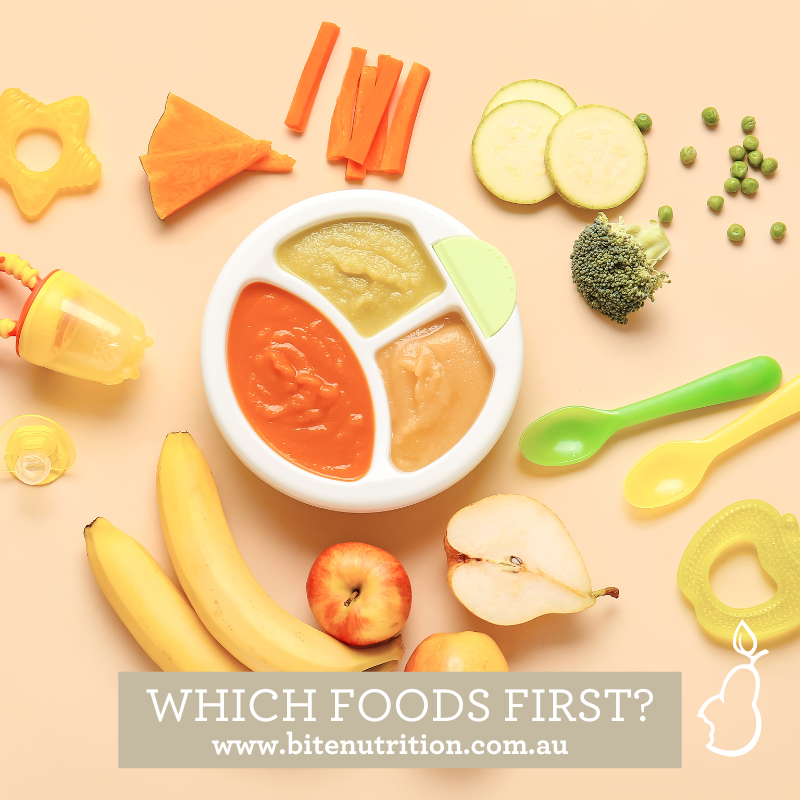Baby Solids Introduction + Weaning: Which Foods First?

Assuming you have read our guide on when you know your baby is ready for solids, and our guide on ensuring you are "solids ready"; the below information will help you with deciding which foods and textures to begin with. If you are ever in doubt, ask your health professional.
First Foods
At 6 months your breast milk and/or infant formula will not support your baby’s growth requirements for iron and zinc. These minerals are essential for the rapid growth they are about to experience.
Introducing bland and/or savory foods is best, as do not forget, they have never tasted food before. If you introduce “sweet” more intense flavors, it will be hard to go back to those blander foods that perhaps offer them more nutrition.
Try not use your taste preferences as a guide for what you think baby will like, as you have had decades of your taste buds developing, dying, regrowing; your taste pleasures now may need additional extremes of flavour such as salt and sugar for things to be “nice”. Babies are so far away from this. They are just beginning their taste journey.
First foods should always be high in iron or fortified – and rice cereal is a good start. Fortified iron rice cereals:
- provide a top up of this much needed mineral (iron) during this peak time for its demand,
- are easy to prepare, in minutes you have food
- are cheap – as most of it initially ends up being played with, spat out, mushed around the table and most importantly,
- it is bland.
Puree vegetables should be next. Try to avoid the fruits as first foods if you can.
The table below provides a guide on the developmental stages and foods to introduce and when. Remember to not add salt, sugar or honey to any of baby’s foods.
Table 1: Food types and textures by age
|
Birth-6months |
Suckling, sucking and swallowing |
Breast Milk/formula |
|
First foods (from around 6 months) |
Increased strength of suck Appearance of early chewing Movement of gag reflex from mid to posterior third of tongue |
Fortified cereals (e.g. rice), vegetables (e.g. legumes, soy beans, lentils), fish, liver, meat and poultry, cooked plain tofu NO SALT or flavours ADDED
|
|
Other nutritious foods to be introduced before 12 months |
Clearing spoon with lips, biting and chewing Lateral movements of tongue and movement of food to teeth |
Cooked or raw vegetables (e.g. carrot, potato, tomato), fruit (e.g. apple, banana, pear), whole egg, cereals (e.g. wheat, oats), bread, pasta, nut pastes, toast fingers and rusks, dairy foods such as full-fat cheese, custards and yoghurt |
|
From 12 to 24 months |
Rotary chewing movement, jaw stability |
Family foods Full-cream pasteurised milk |
Safe Textures of Food
Given a baby has never swallowed anything other than milk fluids before, during months 6 and 7, babies need foods that are puree, mashed or incredibly soft in texture. Remember their little mouths and throats are unfamiliar with swallowing and the texture of the food needs to go down without risk of getting stuck[1].
Food offered should be an appropriate texture and consistency for the infant’s developmental stage:
- from 6months of age, infants should be offered purees and then mashed foods, progressing to minced and chopped foods.
- by 8 months most infants can manage ‘finger foods’
- by 12 months, infants can have nutritious choices from the foods eaten by the rest of the family and should be consuming a wide variety of foods.
Increasing and varying food texture is essential for oral motor development. An infant will quickly learn to manage foods of different textures and will accept food that has been mashed with a fork or minced.
Encouraging an infant to chew is very important and infact, it has been demonstrated that infants not given ‘lumpy’ textured food until after 10 months have greater feeding difficulties at 15 months than those introduced to lumpy food between 6 and 9 months of age. There is a ‘critical window’ of opportunity for introducing these textured foods to reduce the risk of later feeding difficulties. Ofcourse, small, hard pieces of food should be avoided as they can cause choking. You can read our article on choking also.
[1] Foods for your Baby - Variety and Texture | Public Health

